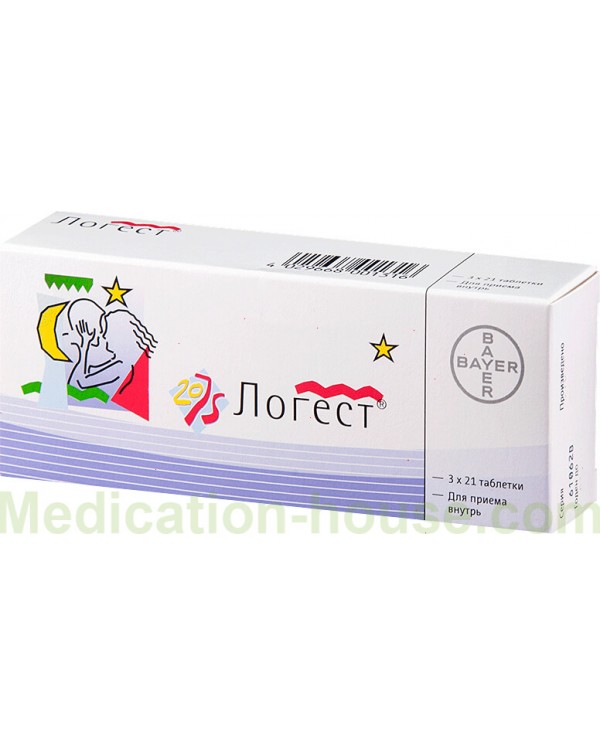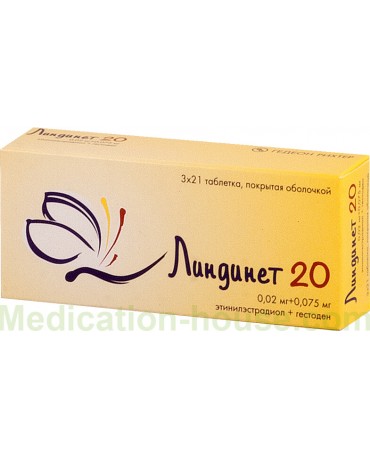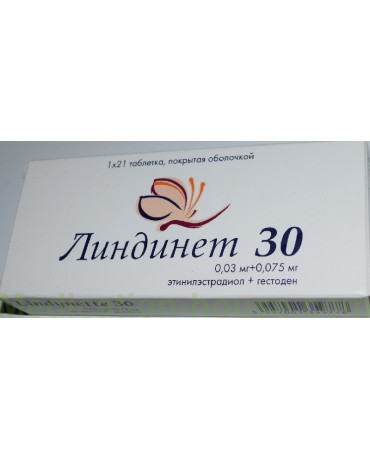Instruction for use of Logest
You can buy Logest here
Logest is a low-dose monophasic combined oral contraceptive estrogen-progestogen drug.
Release form and composition
Dosage forms:
Film-coated tablets: round, white (21 pieces in a blister, in a carton box 1 or 3 blisters);
Dragee: round shape, white (21 pieces in a blister, in a cardboard box 1 or 3 blisters).
The content of the active ingredients of Logest in 1 tablet or 1 dragee:
Gestodene - 0.075 mg;
Ethinylestradiol - 0.02 mg.
Excipients: corn starch, polyvidone 25,000, lactose monohydrate, sucrose, polyvidone 700,000, calcium carbonate, macrogol 6000, mountain glycol wax, magnesium stearate, talc.
Indications for use
The use of Logest is indicated for oral contraception.
Contraindications for Logest
Angina pectoris, transient ischemic attacks and other conditions preceding thrombosis (including history);
Venous and arterial thrombosis, including thromboembolism of the branches of the pulmonary artery, deep vein thrombosis of the lower extremities, cerebrovascular disorders, myocardial infarction, including a history;
Multiple or severe risk factors for arterial or venous thrombosis;
Diabetes mellitus with vascular complications;
Pancreatitis with severe hypertriglyceridemia (including history);
Benign or malignant tumors of the liver (including history);
Severe forms of liver disease, jaundice, including history (until normalization of liver tests);
Migraine with focal neurological symptoms (including history);
Vaginal bleeding of unknown etiology;
Hormone-dependent malignant pathologies of the mammary glands or genital organs (including anamnesis);
The period of pregnancy (or the assumption of its presence) and breastfeeding;
Intolerance to the components of the drug.
With caution, carefully weighing the expected benefits and potential health risks, it is recommended to prescribe Logest to women with the following risk factors: uterine fibroids, fibrocystic mastopathy, smoking, thrombosis, the presence of myocardial infarction in any of the next of kin at a young age, brain disorders circulatory or breast cancer, obesity, dyslipoproteinemia, migraine (with no focal neurological symptoms), valvular heart disease, arterial hypertension, cardiac arrhythmias, major surgery, prolonged immobilization, extensive trauma, systemic lupus erythematosus, liver disease, diabetes mellitus without vascular complications, hemolytic uremic syndrome, ulcerative colitis, Crohn's disease, phlebitis of superficial veins, sickle cell anemia, hypertriglyceridemia.
In addition, a doctor's consultation is required before starting the drug for patients who, against the background of the previous use of sex hormones or during pregnancy, for the first time experienced or worsened pathologies such as cholestasis, jaundice, gallbladder disease, porphyria, otosclerosis with hearing loss, Sydenham's chorea, herpes in pregnancy.
It should be borne in mind that in hereditary angioedema, exogenous estrogens may exacerbate or cause symptoms of angioedema.
Method of application and dosage
Logest is taken orally with a sufficient amount of water.
Dosage regimen: from the first day of the menstrual cycle, 1 tablet or dragee per day (using the drug from the cell corresponding to the day of the week), always at the same time for 21 days. This is followed by a break lasting 7 days, during this period, usually on the 2-3rd day, menstrual-like bleeding begins. On the 8th day after the completion of taking the tablets (pellets) from the first blister, even if the withdrawal bleeding has not ended, you should start taking the drug from the next blister at the set time.
When you start taking the drug from the second to the fifth day of the menstrual cycle, it is recommended to additionally use a barrier method of contraception during the first 7 days of using tablets or dragees from the first blister.
When switching from previous oral contraception, using a contraceptive patch or vaginal ring, it is preferable to start taking Logest: the next day after the last hormone-containing tablet of the previous drug (including 21 tablets), but no later than the day following the seven-day break or after the last inactive tablet from the package for 28 tablets; on the date of removal of the patch or vaginal ring, but no later than the expected date of gluing a new patch or inserting a new ring.
A woman can switch from gestagen-containing contraceptives mini-pills without interruption (on any day), an implant or an intrauterine contraceptive (Mirena), releasing a progestogen - on the day of their removal, an injection form - on the day of the proposed next injection. In each case, it is necessary to additionally use barrier methods of contraception during the first 7 days.
A woman can start taking the drug after an abortion in the first trimester of pregnancy on the day of the operation without the use of additional contraceptive measures.
Taking the drug after an abortion in the second trimester of pregnancy or childbirth is recommended to start on the 21-28th day after surgery or childbirth, if there is no breastfeeding. With a later start of oral contraception, taking tablets or dragees during the first 7 days should be accompanied by additional methods of contraception. If during the period after an abortion or childbirth a woman had sexual intercourse, it is necessary to exclude the presence of pregnancy or start taking Logest with the onset of the first menstruation.
Contraceptive protection depends on compliance with the regularity of taking the drug.
If you are late in taking the next pill (pellets) less than 12 hours, contraception is not violated. You should take the missed dose of the drug as soon as you remember, and continue taking it as usual.
Contraceptive protection is reduced if the appointment is more than 12 hours late. The closer the skip of the next dose to the seven-day break and the more missed pills (pellets), the more the likelihood of pregnancy increases. A break in admission should never exceed 7 days. The recommended dosing regimen should always be observed, since 7 days of continuous administration of the drug are required to achieve the required suppression of hypothalamic-pituitary-ovarian regulation.
In case of accidental delay in taking the prescribed time by more than 12 hours (more than 36 hours since the last dose was taken) in the first week of using Logest, the missed tablet (pellet) should be taken as soon as remembered, even if you have to take 2 doses at the same time. Further, the drug is taken as usual. Over the next 7 days, you should resort to additional methods of contraception. If there was sexual contact during the previous week before the pass, there is a chance of conception.
If you are more than 12 hours late in the second week of therapy, the drug should be taken immediately, even if this means taking 2 tablets (pellets) at the same time. The following tablets (pellets) are taken at the prescribed time. If in the last 7 days before the delay the drug was taken without violations of the regimen, additional barrier contraceptive measures are not required. In case of violation of the regimen of use or skipping more than two tablets (pellets) - over the next 7 days of taking the drug, barrier methods of contraception are required.
If you miss the next dose in the third week of therapy, the reliability of contraception is at great risk due to the upcoming 7 days of interruption in admission. Subject to the regularity in taking the previous 7 tablets (pellets), additional barrier methods are not required. Having taken the missed dose, you can continue taking the drug from the current blister at the set time, and without making a seven-day break, start taking the drug from the next blister. In this case, menstrual-like bleeding until the end of the next blister is unlikely, spotting or breakthrough bleeding may occur.
The second option for skipping a pill (dree) in the third week of therapy is to interrupt the drug from the current blister and a premature seven-day break (including the day of the skip) and continue using the next blister as recommended.
In the absence of withdrawal bleeding in the interval between taking the drug against the background of missing tablets (pellets), you should consult a doctor to exclude pregnancy.
If vomiting or diarrhea occurs within 4 hours of taking a dose of the drug, due to the risk of incomplete absorption, it is necessary to take the measures provided for in the recommendations for skipping a dose.
If you want to delay the onset of withdrawal bleeding, you should continue taking Logest from the next blister without interruption after the completion of the previous blister. You can continue taking it until the completion of all tablets (pellets) in the blister. During this period, spotting or breakthrough uterine bleeding may occur. After a seven-day break, you should continue using the drug from a new blister.
To change the day of withdrawal bleeding to the desired day of the week, the next break should be shortened by the required number of days. The probability of the absence of withdrawal bleeding is higher, the shorter the break in taking, however, the risk of spotting spotting and breakthrough bleeding increases when taking the drug from the next blister.
Side effects of Logest
Reproductive system: sometimes - spotting during the period of taking the drug during the first months, changes in vaginal secretion;
Nervous system: sometimes - headache, decreased mood, migraine;
Digestive system: sometimes - vomiting, nausea;
Endocrine system: sometimes - an increase and a feeling of tension in the mammary glands, a change in body weight, a decrease / increase in libido;
Others: possibly - fluid retention in the body, impaired tolerance to contact lenses, the development of allergic reactions.
Special instructions
Before starting the use of the drug, the patient must undergo a complete gynecological (including examination of the mammary glands and cytological examination of cervical mucus) and general medical examination, to exclude violations of the blood coagulation process and pregnancy.
It should be borne in mind that against the background of taking the drug in women over 35 years old and smoking, the risk of arterial thrombosis increases.
The likelihood of developing thrombosis is increased with obesity, arterial hypertension, atrial fibrillation, heart valve disease, aggravated family history, dyslipoproteinemia.
Due to the risk of thrombosis, the use of the drug should be discontinued 6 weeks before a planned surgical operation and during a period of prolonged immobilization. Resume oral combined contraception should be after immobilization after 2 weeks.
In the event of swelling and pain along the veins in the lower extremities, sudden shortness of breath, acute pain and a feeling of heaviness in the chest, stop taking the tablets (pellets) and consult a doctor.
Against the background of the use of hormonal contraceptives, it is possible to change the normal menstrual cycle, the properties of cervical mucus, and rectal temperature.
If you experience severe pain in the lower abdomen, continuous skin itching, migraines, severe headaches, severe depression, a significant increase in blood pressure, a sudden change in hearing, visual perception or speech, an increase in seizures, the drug should be discontinued and an appropriate examination should be carried out.
In the period of the first months of adaptation of the body, the appearance of intermenstrual minor spotting is allowed, in case of an increase in their intensity or the appearance in a later period of using Logest, you should consult a doctor.
In the absence of withdrawal bleeding during the seven-day break in taking the drug, you must consult a doctor before taking the tablets (pellets) from the new blister.
With the simultaneous use of drugs that affect the effectiveness of Logest, it is recommended to use additional barrier contraceptives during the period of treatment and the next 7 days, and with rifampicin therapy - 4 weeks after the end of the intake.
Patients prone to the appearance of chloasma are advised to avoid direct sunlight during the period of use of the drug.
Drug interaction
Concomitant therapy with other drugs may cause a decrease in the contraceptive effectiveness of oral contraceptives and / or breakthrough bleeding. During this period, it is recommended to additionally use barrier or other methods of contraception.
The effectiveness of Logest is reduced with the simultaneous use of ampicillin, rifampicin, tetracyclines, non-steroidal anti-inflammatory drugs, griseofulvin, phenytoin, carbamazepine, phenobarbital.
When prescribing other drugs, a woman should inform her doctor about taking a combined oral contraceptive estrogen-progestogen.
Terms and conditions of storage
Keep out of the reach of children:
Tablets - at temperatures up to 25 ° C, in a place protected from light;
Dragee - at room temperature.
Shelf life: tablets - 3 years, dragees - 4 years.
Terms of sell
You can buy Logest without a prescription.



